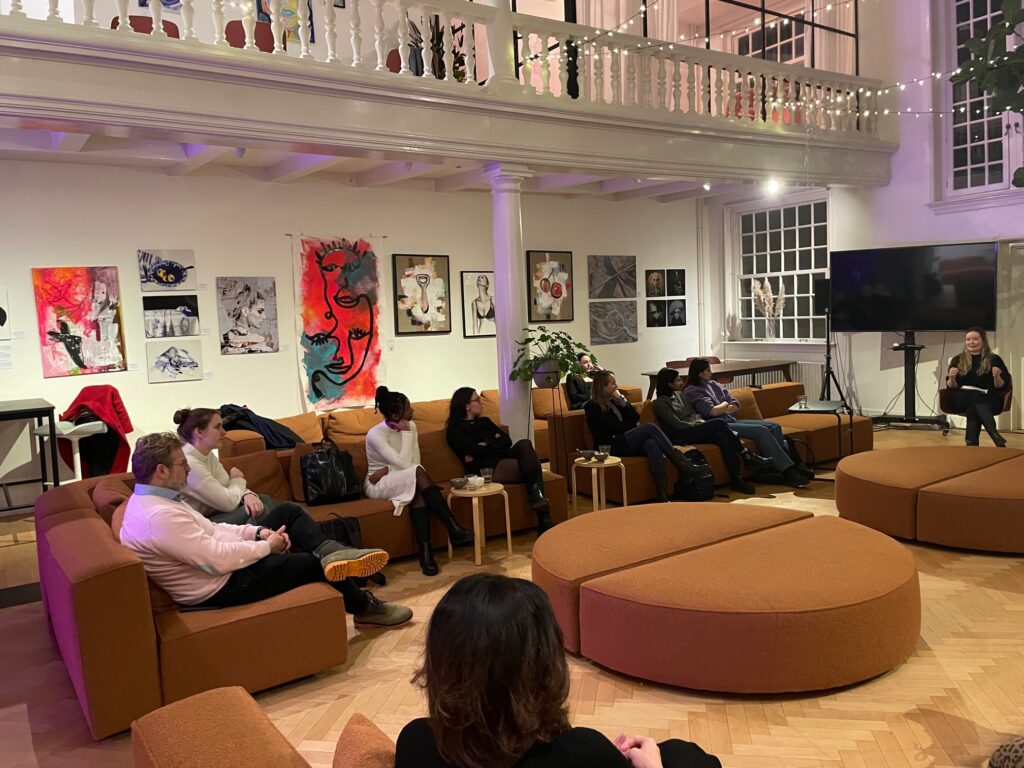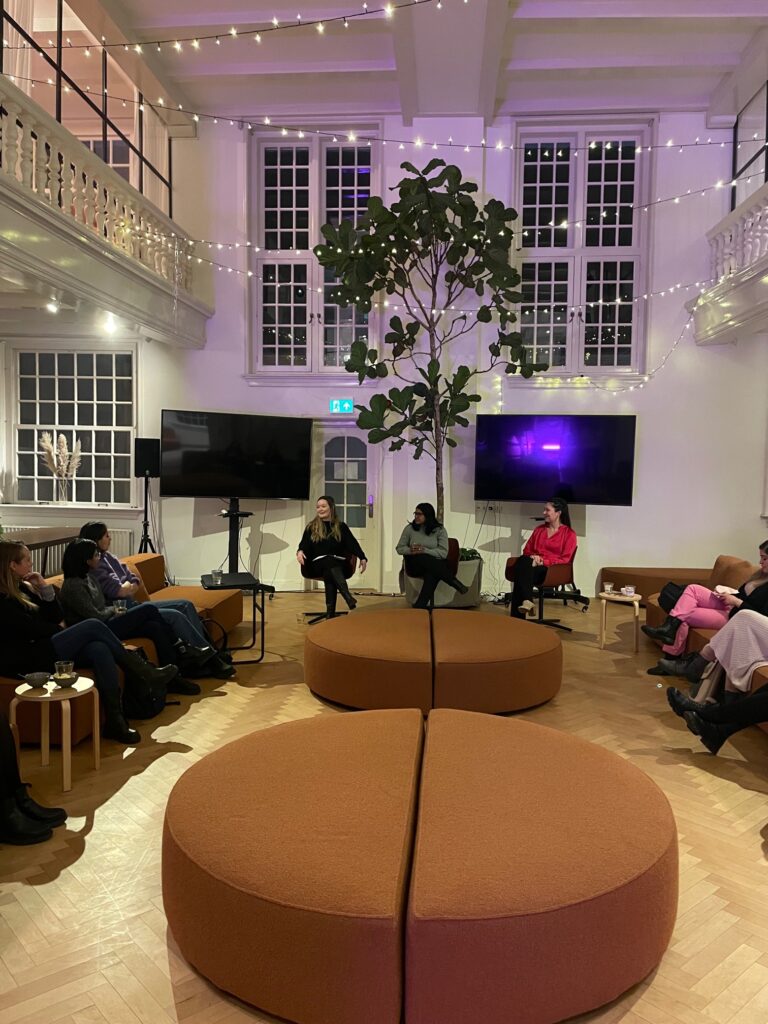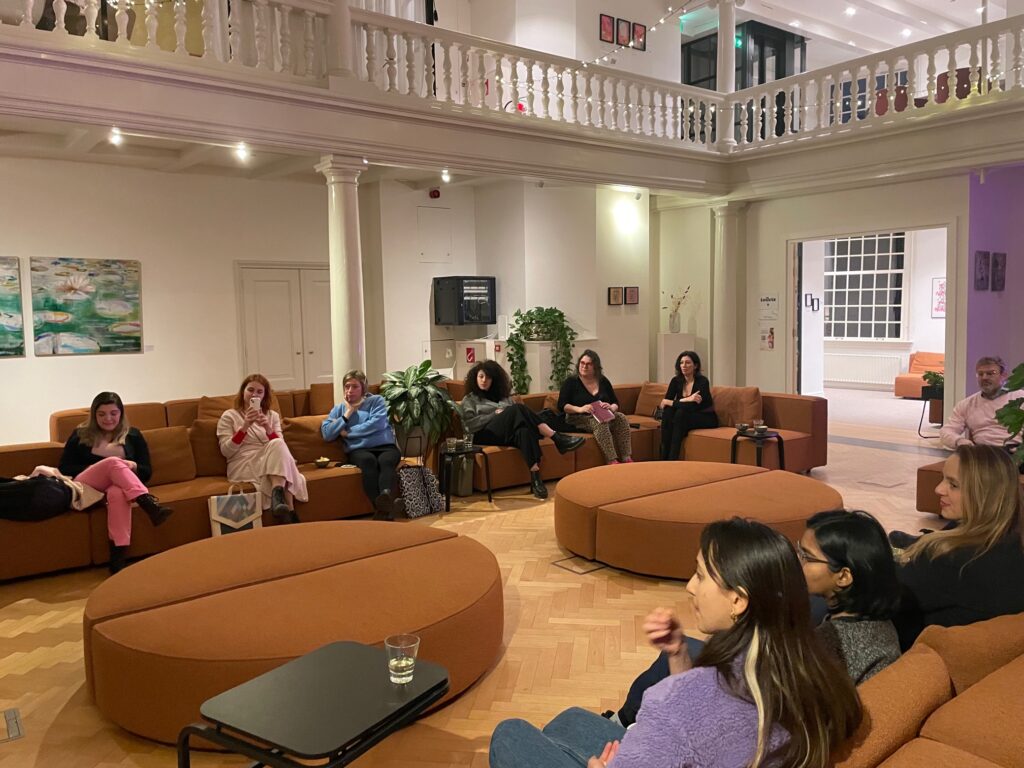
Leading AI teams: Insights from industry experts
This new year we started off with a Circle event about leading AI teams. Guided by Aoibhinn Reddington, two experts in the field shared their experiences and perspectives on managing these types of teams. What are the hurdles to overcome, how do you create a safe space for your team and keep them aligned? During the event we also talked about unconscious biases and the way you can avoid those in order to create a more diverse team.
Author: Ingrid van Heuven van Staereling.
As a former data science manager (currently Head of Modelling) and responsible AI advocate Natasha Govender-Ropert gave us some insights into her journey from a technical role to management. She highlighted the frustration she initially felt with administrative tasks. After working in various roles, she emphasized her current focus on the engineering side of productionisation. Coming from an AI consulting side, Laura Brandwacht discussed her role in leading both program/project teams and a transformation team. She strongly believes in the importance of combining expertise and ensuring the implementation of data AI projects.
The conversations touched upon team dynamics, with Laura detailing how team size varies based on the project’s nature, ranging from small, strategic teams to larger ones for implementation. Natasha stressed the importance of psychological safety within teams. The most important part of leading a team is transparency and open communication to build trust. But also leading by example, Laura adds, by being open and sharing as a leader. “I try to also share my challenges, doubts or difficulties within the team.” This gives your team the opportunity to do so too. “And if people share things with you, you really need to do something with it!”

Male-dominated fields and biases
The conversation also delved into the challenges faced by male-dominated fields. Natasha shared her experiences in addressing biases in the hiring process and the need to challenge subtle biases in technical interviews. “I think it’s also important to be aware and cognizant of the fact that these biases do exist.” – Natasha said. Laura agrees that awareness is crucial. That is why her company actively includes a female interviewer in every interview to counteract biases. With positive results, according to Laura: “It really makes a difference!”
Natasha shares one of the things that also frustrates her when it comes to biases. “One of the things that also frustrates me is when in meetings you say something and two minutes later, a male counterpart says exactly the same thing.” That’s when you see the difference between the reaction male and female experts sometimes get. “He will get a reaction, whereas yours was just kind of passed.” Nowadays she stops meetings to let him know she’s glad he agreed with her since it’s the same point she made a couple of minutes ago. But she agrees it is a difficult situation to handle. “You don’t want to come across as being aggressive. Then people might think you want credit for everything.” But both Laura and Natasha agree that it is important to address bias when you see it.
Navigating through the day-to-day workload
Both Natasha and Laura use agile work approaches to get around their days. “We have the tech side, we have the business side and we have all the users of the platform.” Natasha describes the different teams which she has meetings with. “A lot of my time is spent with just ensuring that the platform is running.” This involves regular meetings with her team and management to align on goals and address the challenges that they come across. In her current role she mostly focuses on stakeholder management and creating alignment within the team.
Laura explains about the dynamic interaction with her team and the clients. The structure of their meetings varies based on client preferences. She emphasized the importance of goal-specific meetings and maintaining a balance between discussing content and addressing personal development and strategic considerations. “Working with technical people the risk is that you only talk about content and problems. You dive into the content every time.” Both speakers acknowledged the need for leaders to prioritize self-time for strategic thinking and to maintain a balance between being available for the team and setting up boundaries.
Setting aside dedicated time for personal reflection is very important. Natasha mentioned the implementation of blocking out two hours daily for strategic thinking. Especially with everybody expecting an answer instantly nowadays. “It’s really important to also prioritize yourself and your team.” Natasha believes that when you’re in a good space where you can actually think about your team, it has positive benefits for you and your team. Leaders also need to take the tie to consider the big picture. “As a manager, a leader it is really important to take time to step back.” She states it helps her to reflect and continually optimize processes. “And one of the things I’ve noticed is that people adjust to your routine.” Natasha dedicates specific times for email responses and maintaining focused, uninterrupted periods for deep work. Once you establish a routine that aligns with your productivity, people will adapt, resulting in improved efficiency and work-life balance. So it’s all about keeping a balanced approach to the company’s, your personal and the team priorities.
A technology that is not understood
There are challenges when it comes to introducing AI in business settings where there is a varying level of AI literacy among the stakeholders. Natasha shares her experience in the financial sector, where resistance to incorporating machine learning arose due to a lack of understanding among stakeholders. To address this, she organized learning sessions and roadshows, showcasing the practical value of analytics and small POC’s. By objectively demonstrating the improvements, she managed to gain stakeholder buy-in. “It was a long tedious process, but this is what we have to do. Because if people are not AI literate, they can quickly shy away from it.” It is very important to demonstrate value and maintain objectivity when dealing with stakeholders who may not be familiar with AI.

Laura adds that there is a need to tailor AI approaches based on the audience’s expertise. She shares an example from a car pricing program where pricing experts initially resisted AI involvement in their work. To bridge the gap, they started with a simple linear regression model, explaining its influence on prices, and gradually introduced more complex models. “If we introduced the complex models immediately it would not have worked.” -Laura explains. She definitely believes it is important to involve users with varying degrees of AI or statistical knowledge.

The roles within the team
When it comes to building successful AI solutions it is important to integrate different roles within the teams you work with. “Everyone has a specific expertise and as a leader you need to think about how to involve all these different kinds of people.” Laura tells us about the different type of people that are a big part of the whole team. “I have people that are part of what we call the transformation team. They have a more strategic mindset.” In her experience those are the type of people that are much more comfortable with a vague question. On the other hand she also has the more die hard data science people. “They really want to ask questions and want to understand what their rules are in the bigger picture.” In her last example she talk about the technical people. “They also need to have a concrete goal.” She explains how they usually want some freedom and acknowledgement of their expertise. “I think it’s really interesting to play with it as a leader.” Laura feels so lucky to work with people that have such a specific, and at the same time show interest in each other. “That’s super important in building AI systems!” She sees a lot of companies where data science, tech and IT are separated worlds. “I think you can only build successful solutions if you really connect them. And that’s not always easy, but it’s so cool!”
According to Natasha, you also have to deal with the challenges and misconceptions surrounding the role of data scientists in AI teams. Natasha noticed that many data scientists often have misconceptions about their role, expecting to primarily focus on building complex models. She highlights the importance of aligning expectations during interviews, giving a realistic picture of the daily responsibilities, which involves a significant amount of time spent on data cleaning and understanding. She also stresses the need to find a balance between building the best model and delivering results within a reasonable timeframe. “It’s important to keep them realistic in terms of what is good enough so then they can stop fine tuning their hyperparameters.” Sometimes the business perspective is forgotten when building a model. Having engineers in your team can help. “To ensure that when you take a model into production it is optimized and can scale.”
How do you keep your team members motivated? Laura thinks that good examples and training sessions can help. She explains the importance of distinguishing different horizons of data-driven work, from insight-driven organizations to AI-driven business models. There’s always a challenge of inspiring a team, especially when dealing with complex tasks. But at the same time she believes those are the biggest learning opportunities. According to Natasha you can always try to focus on the objective and business value of a project. But als to encouraging team members to find elements in a project that contribute to their own growth and learning. Even in less glamorous or challenging projects there are lessons to be learned and it’s the task of a leader or manager to point them out.
The future of AI use
But how do you deal with the ever evolving landscape of AI and its societal implications? What are the future needs for specialists in AI and will everyone become adept at interacting with AI systems? Laura thinks we can only hope for widespread awareness and education. That starts by teaching the younger generations about responsible AI use. “But I think it’s even more important that technology will become easier and easier to implement.” She stresses the necessity of thinking about AI implementation from a business perspective, considering its value and responsibility.

Additionally, Natasha builds on this by highlighting challenges in disseminating AI knowledge. “I actually find that a lot of companies are very hesitant to use and implement AI. Because they don’t understand the consequences.” A lot of companies have regulatory concerns. And yes, they both agree there is a need for ethical considerations and responsible AI practices. Natasha discusses the balance between democratizing AI and ensuring a fundamental understanding of its implications. Especially regarding biases and discrimination in historical data. Laura believes that as technology becomes more accessible, there should be an emphasis on understanding data, statistics, and models, rather than just building complex AI systems. She explains how even schools are banning the use of AI. “We should teach young people how to use AI in a responsible way and make sure they know how to check it and what to put in there.”
Growing into a leading role
One of the audience members is curious to know how you can grow your career from a junior to a leading position. The first step Natasha thinks you should take: “Make sure you communicate it to your manager.” Stating your ambitions and seeking guidance on achieving those goals is the starting point. The advice is to be explicit about what you want and make it tangible, like discussing the timelines, and bridging any identified gaps. As women in the field you definitely need to be proactive, Laura emphasizes: “Sometimes as women we tend to wait and think ‘they will ask me and if they think I am good enough’.”
Our experts suggest reaching out to mentors, even outside the immediate work environment, to seek guidance on navigating one’s career path. “Don’t wait to get the opportunity to go there.” -Laura says. The importance of having a mentor is even more highlighted. Think about reaching out to leaders for guidance and both speakers tell our audience that they witnessed a willingness among people to offer support. But the important part is, start to actively pursue your career goals, seek mentorship, and make sure you are not being discouraged by initial setbacks.